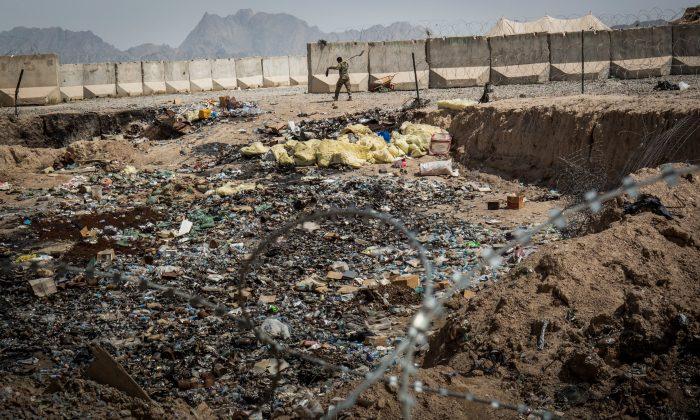The cost of war often exceeds the cold statistics, from the number of dead to those of injuries. Today, the old calculus is not enough to accurately reflect the damage wrought by modern warfare.
Beyond lost limbs and post-traumatic stress disorder, both ruining countless veterans’ lives in the wars of Iraq and Afghanistan, a new pestilence, a new stealth enemy has followed the troops home from the battlefields.
In the new book, “The Burn Pits: The Poisoning of America’s Soldiers” (Hot Books), author and U.S. Marine and Army veteran Joseph Hickman guides the reader on a tour that probes the little reported, dark side of war. Thought provoking, sobering, and infuriating at the same time, “The Burn Pits” hits the mark on many levels.
At the core, “The Burn Pits” central thesis claims giant garbage dumps that burned all day exposed the soldiers, contractors, and locals living nearby the bases and camps to toxins and carcinogens. People didn’t notice the ailments, the creep of the poisons until some of the troops came down with rare but acute cancers and began to die.

It was the Vietnam War’s Agent Orange all over again blended with the acrid fallout of the World Trade Center’s ‘Ground Zero.’
“The Burn Pits” places part of the blame on a Department of Defense (DoD) that provided zero oversight on its base contractors in charge of disposing the military and troops’ waste during the wars in Iraq and Afghanistan. In disposing of their contract specifications, with respect to basic care and adhering to safety procedures instead, Kellogg, Brown and Root (KBR) and Halliburton dumped all of the human waste, refuse, degraded equipment and much more in large scale, open air pits, where the debris piles burned continuously around the clock.
Worse Than ‘Ground Zero’
Hundreds of ‘Ground Zero’ pits scarred the landscape throughout war-torn Iraq and Afghanistan. The pits burned on month after month, spewing toxic smoke and plumes seeded with particulate of heavy metals, radioactive isotopes, human flesh, and tissue. They burned not out in some far off field or behind a tall mountain range, but in and around the camps and bases, which were often located near cities and densely populated areas.
At first glance, how much garbage could there be? The book shows that just one soldier generated ten pounds of waste per day. Doesn’t seem like much. But at second glance, it’s ten times more than the troops in Vietnam War discarded. We live in a disposable age—bottled water, throwaway trays and boxes, while in Vietnam they used canteens and reused their food trays. Now run the 10 pounds a day across 365 days and the amount of waste a single person in either theater of war created was just under two tons a year. With 50,000 troops in Iraq, and as many in the other war, the amount of waste produced becomes staggering.

Mason Kinsey Photography LLC
If the soldiers’ waste was the only thing that KBR burned in those pits, the adverse events might not have been so bad, and the Houston-based multinational might not be in court defending itself in at least three different class action lawsuits from the injured, dying and, yes, dead servicemen’s families.
Beyond the soldiers, KBR dumped gear, spent ammunition, computers, furniture, medical waste, radioactive material, supplies, plastics, metals, and clothing. The enormity of the operation comes into focus when the toxic stew poisoned tens of thousands of troops, and many villagers in Iraq and Afghanistan, too.
Since 2009, research scientists have published nearly two-dozen studies, underscoring the 15 percent rise in birth defects in Fallujah, Iraq. One such study, “Birth Outcomes Among Military Personnel After Exposure to Documented Open-Air Burn Pits Before and During Pregnancy” (A.M. Conlin, et al.), was conducted by the Naval Health Research Center—a clear conflict of interest to disprove any links between the toxic air and the array of rare cancers and rarer diseases that contaminated the young and once healthy soldiers.
Toxic Air and Hot Ground
Joseph Hickman calls out the Agent Orange white washing after the Vietnam War. The old CDC template, “showing” no association between dioxin and the poisoning of hundreds of thousands of U.S. troops and many more Vietnamese soldiers and citizens, has been dusted off and reused for this century’s wars.
To make matters worse, Hickman further uncovers many of the bases had been built on “hot ground.” In other words, sites previously contaminated from the First Gulf War or when Saddam’s army had stockpiled old nerve agents and chemical weapons from the 1980s Iraq-Iran War, in which those weapons were used near the end of that eight-year war against Iranian troops and civilians.
The real kicker comes when we learn that the supplier of those old weapons of mass destruction (WMD) came from the United States during the Reagan Administration. In a simple Occam’s razor straight line, from George H.W. Bush, then as vice president and in 1989 as president of the United States, it becomes clear why his son George W. Bush, a decade later, never disclosed that WMDs were actually found in Iraq. The ordinances just happened to be old, made in America.
In going the last mile, Joseph Hickman uncovers the “don’t care” attitude that is pervasive in the DoD, the blame game from its contractors, and the grotesque inertia at the VA hospitals in rejecting any and all claims of pain, suffering, injury, and death by the soldiers who fought in those wars from the burn pits.
What this author would like to see would be a separate book on the history of Iraq’s chemical weapons stockpile, its use during the 1980s war with Iran, and the cover up by the George W. Bush Administration during the first few years of the Iraq War.
Then only one question remains: Has any group of scientists ever compared the array of diseases between the wars in Iraq and Afghanistan?
One would suspect that, in the latter, no WMDs were ever used by or against the Taliban and al-Qaeda. If that is the case, then there should be more exotic and rare diseases coming from the Iraq theater, where today the Islamic State has captured some ground.
‘The Burn Pits, the Poisoning of America’s Soldiers’
By Joseph Hickman
Hot Books
160 pages, $21.99
For more information on burn pits, visit the Burn Pits Action Center.
James Grundvig will have three books published by Skyhorse Publishing, a partner with the Hot Books imprint: Two non-fiction, not related to war; one novel, a military thriller not related to the Burn Pits.






